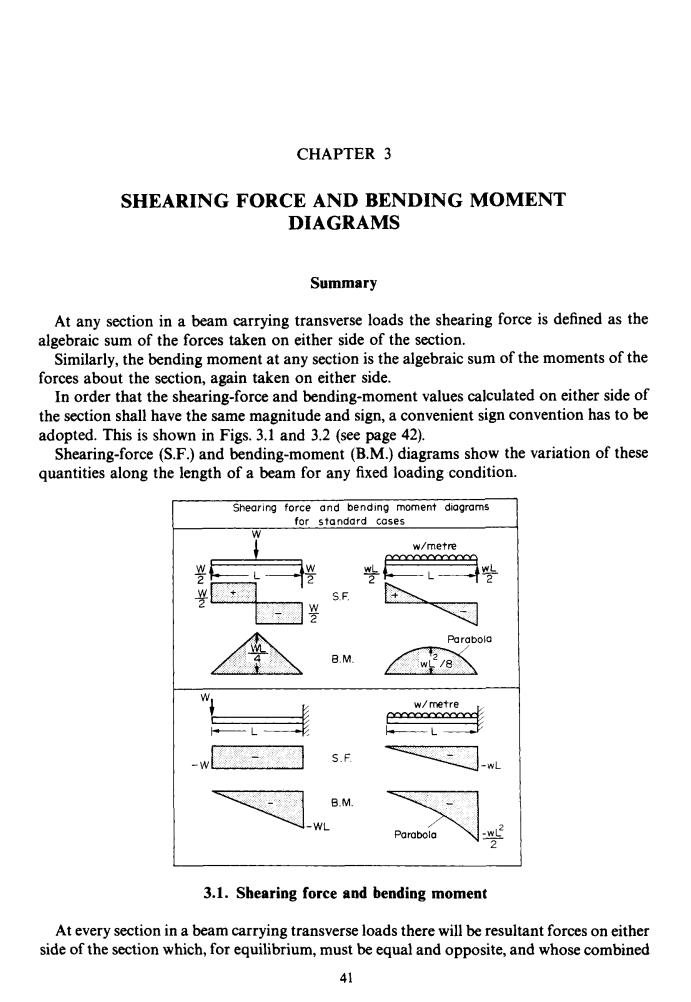
CHAPTER 3 SHEARING FORCE AND BENDING MOMENT DIAGRAMS Summary At any section in a beam carrying transverse loads the shearing force is defined as the algebraic sum of the forces taken on either side of the section. Similarly,the bending moment at any section is the algebraic sum of the moments of the forces about the section,again taken on either side. In order that the shearing-force and bending-moment values calculated on either side of the section shall have the same magnitude and sign,a convenient sign convention has to be adopted.This is shown in Figs.3.1 and 3.2 (see page 42). Shearing-force(S.F.)and bending-moment(B.M.)diagrams show the variation of these quantities along the length of a beam for any fixed loading condition. Shearing force and bending moment diagrams for standard cases w/metre xx S.F Parabola B.M. w生B w/metre sexxx S.F B.M. Parabola 3.1.Shearing force and bending moment At every section in a beam carrying transverse loads there will be resultant forces on either side of the section which,for equilibrium,must be equal and opposite,and whose combined 41
CHAPTER 3 SHEARING FORCE AND BENDING MOMENT DIAGRAMS Summary At any section in a beam carrying transverse loads the shearing force is defined as the algebraic sum of the forces taken on either side of the section. Similarly, the bending moment at any section is the algebraic sum of the moments of the forces about the section, again taken on either side. In order that the shearing-force and bending-moment values calculated on either side of the section shall have the same magnitude and sign, a convenient sign convention has to be adopted. This is shown in Figs. 3.1 and 3.2 (see page 42). Shearing-force (S.F.) and bending-moment (B.M.) diagrams show the variation of these quantities along the length of a beam for any fixed loading condition. Para bola BM I w. -wL SF I -w BM -Wf -WL - 2 3.1. Shearing force and bending moment At every section in a beam carrying transverse loads there will be resultant forces on either side of the section which, for equilibrium, must be equal and opposite, and whose combined 41
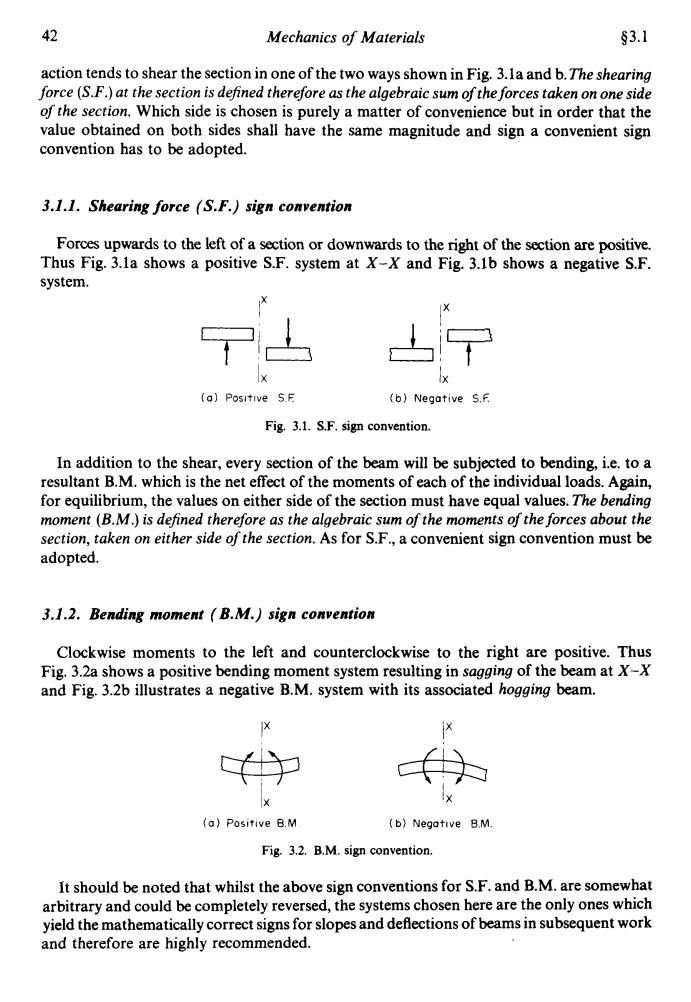
42 Mechanics of Materials §3.1 action tends to shear the section in one of the two ways shown in Fig.3.la and b.The shearing force (S.F.)at the section is defined therefore as the algebraic sum of the forces taken on one side of the section.Which side is chosen is purely a matter of convenience but in order that the value obtained on both sides shall have the same magnitude and sign a convenient sign convention has to be adopted. 3.1.1.Shearing force (S.F.)sign convention Forces upwards to the left of a section or downwards to the right of the section are positive. Thus Fig.3.1a shows a positive S.F.system at X-X and Fig.3.1b shows a negative S.F. system. (o】Positive S.E (b)Negative S.F Fig.3.1.S.F.sign convention. In addition to the shear,every section of the beam will be subjected to bending,i.e.to a resultant B.M.which is the net effect of the moments of each of the individual loads.Again, for equilibrium,the values on either side of the section must have equal values.The bending moment(B.M.)is defined therefore as the algebraic sum of the moments of the forces about the section,taken on either side of the section.As for S.F.,a convenient sign convention must be adopted. 3.1.2.Bending moment B.M.)sign convention Clockwise moments to the left and counterclockwise to the right are positive.Thus Fig.3.2a shows a positive bending moment system resulting in sagging of the beam at X-X and Fig.3.2b illustrates a negative B.M.system with its associated hogging beam. (a)Positive B.M (b)Negative B.M. Fig.3.2.B.M.sign convention. It should be noted that whilst the above sign conventions for S.F.and B.M.are somewhat arbitrary and could be completely reversed,the systems chosen here are the only ones which yield the mathematically correct signs for slopes and deflections of beams in subsequent work and therefore are highly recommended
42 Mechanics of Materials $3.1 action tends to shear the section in one of the two ways shown in Fig. 3.la and b. The shearing force (S.F.) at the section is defined therefore as the algebraic sum of the forces taken on one side of the section. Which side is chosen is purely a matter of convenience but in order that the value obtained on both sides shall have the same magnitude and sign a convenient sign convention has to be adopted. 3.1.1. Shearing force (S.F.) sign convention Forces upwards to the left of a section or downwards to the right of the section are positive. Thus Fig. 3.la shows a positive S.F. system at X-X and Fig. 3.lb shows a negative S.F. system. tX A!'? 723 (b) Negative Ix 5.E IX (a) Positive 5 F: Fig. 3.1. S.F. sign convention. In addition to the shear, every section of the beam will be subjected to bending, i.e. to a resultant B.M. which is the net effect of the moments of each of the individual loads. Again, for equilibrium, the values on either side of the section must have equal values. The bending moment (B.M.) is defined therefore as the algebraic sum of the moments of the forces about the section, taken on either side of the section. As for S.F., a convenient sign convention must be adopted. 3.1.2. Bending moment (B.M.) sign convention Clockwise moments to the left and counterclockwise to the right are positive. Thus Fig. 3.h shows a positive bending moment system resulting in sagging of the beam at X-X and Fig. 3.2b illustrates a negative B.M. system with its associated hogging beam. IX IX Wb IX e IX (a) Positive B M (b) Negative B.M Fig. 3.2. B.M. sign convention. It should be noted that whilst the above sign conventions for S.F. and B.M. are somewhat arbitrary and could be completely reversed, the systems chosen here are the only ones which yield the mathematically correct signs for slopes and deflections of beams in subsequent work and therefore are highly recommended
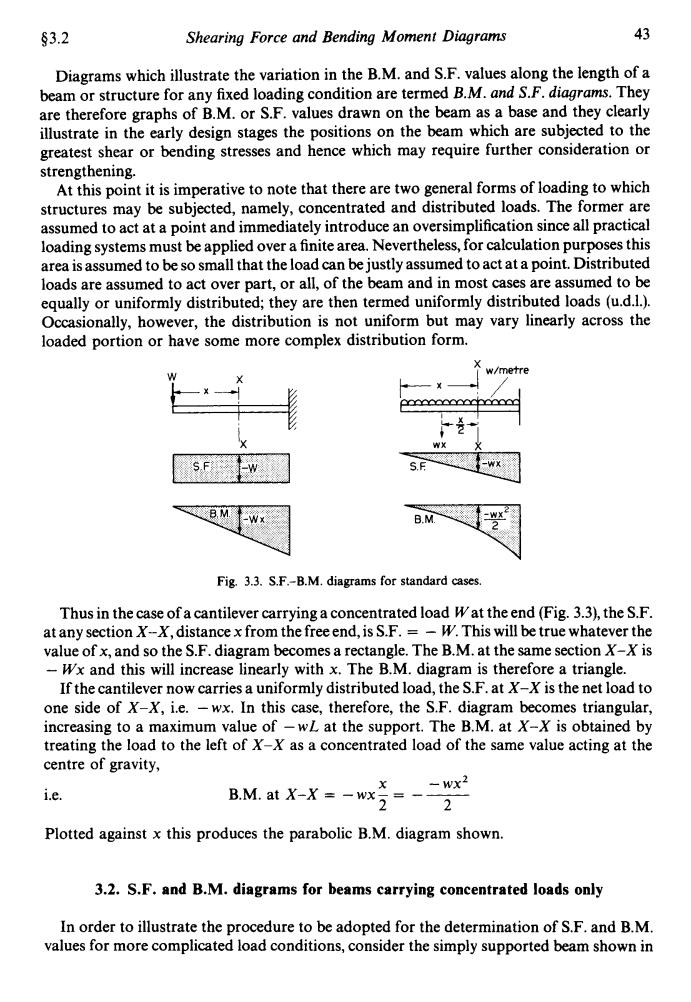
§3.2 Shearing Force and Bending Moment Diagrams 43 Diagrams which illustrate the variation in the B.M.and S.F.values along the length of a beam or structure for any fixed loading condition are termed B.M.and S.F.diagrams.They are therefore graphs of B.M.or S.F.values drawn on the beam as a base and they clearly illustrate in the early design stages the positions on the beam which are subjected to the greatest shear or bending stresses and hence which may require further consideration or strengthening. At this point it is imperative to note that there are two general forms of loading to which structures may be subjected,namely,concentrated and distributed loads.The former are assumed to act at a point and immediately introduce an oversimplification since all practical loading systems must be applied over a finite area.Nevertheless,for calculation purposes this area is assumed to be so small that the load can be justly assumed to act at a point.Distributed loads are assumed to act over part,or all,of the beam and in most cases are assumed to be equally or uniformly distributed;they are then termed uniformly distributed loads(u.d.1.). Occasionally,however,the distribution is not uniform but may vary linearly across the loaded portion or have some more complex distribution form. w/metre aaaaaaach0 S.F B.M Fig.3.3.S.F.-B.M.diagrams for standard cases. Thus in the case of a cantilever carrying a concentrated load Wat the end(Fig.3.3),the S.F. at any section X-X,distance x from the freeend,is S.F.=-W.This will be true whatever the value of x,and so the S.F.diagram becomes a rectangle.The B.M.at the same section X-X is -Wx and this will increase linearly with x.The B.M.diagram is therefore a triangle. If the cantilever now carries a uniformly distributed load,the S.F.at X-X is the net load to one side of X-X,i.e.-wx.In this case,therefore,the S.F.diagram becomes triangular, increasing to a maximum value of-wL at the support.The B.M.at X-X is obtained by treating the load to the left of X-X as a concentrated load of the same value acting at the centre of gravity, i.e. .-wx2 B.M.at X-X -wx2=-- 2 Plotted against x this produces the parabolic B.M.diagram shown. 3.2.S.F.and B.M.diagrams for beams carrying concentrated loads only In order to illustrate the procedure to be adopted for the determination of S.F.and B.M. values for more complicated load conditions,consider the simply supported beam shown in
$3.2 Shearing Force and Bending Moment Diagrams 43 Diagrams which illustrate the variation in the B.M. and S.F. values along the length of a beam or structure for any fixed loading condition are termed B.M. and S.F. diagrams. They are therefore graphs of B.M. or S.F. values drawn on the beam as a base and they clearly illustrate in the early design stages the positions on the beam which are subjected to the greatest shear or bending stresses and hence which may require further consideration or strengthening. At this point it is imperative to note that there are two general forms of loading to which structures may be subjected, namely, concentrated and distributed loads. The former are assumed to act at a point and immediately introduce an oversimplification since all practical loading systems must be applied over a finite area. Nevertheless, for calculation purposes this area is assumed to be so small that the load can be justly assumed to act at a point. Distributed loads are assumed to act over part, or all, of the beam and in most cases are assumed to be equally or uniformly distributed; they are then termed uniformly distributed loads (u.d.1.). Occasionally, however, the distribution is not uniform but may vary linearly across the loaded portion or have some more complex distribution form. 'X wx k Fig. 3.3. S.F.-B.M. diagrams for standard cases. Thus in the case of a cantilever carrying a concentrated load Wat the end (Fig. 3.3), the S.F. at any section X-X, distance x from the free end, is S.F. = - W. This will be true whatever the value of x, and so the S.F. diagram becomes a rectangle. The B.M. at the same section X-X is - Wx and this will increase linearly with x. The B.M. diagram is therefore a triangle. If the cantilever now carries a uniformly distributed load, the S.F. at X-X is the net load to one side of X-X, i.e. -wx. In this case, therefore, the S.F. diagram becomes triangular, increasing to a maximum value of - WL at the support. The B.M. at X-X is obtained by treating the load to the left of X-X as a concentrated load of the same value acting at the centre of gravity, i.e. X - wx2 B.M. at X-X = - wx - = - __ 2 2 Plotted against x this produces the parabolic B.M. diagram shown. 3.2. S.F. and B.M. diagrams for beams carrying concentrated loads only In order to illustrate the procedure to be adopted for the determination of S.F. and B.M. values for more complicated load conditions, consider the simply supported beam shown in

44 Mechanics of Materials §3.2 5m 20 kN 30 kN UIO kN -2m。 m 4 m R 12m Fig.3.4. Fig.3.4 carrying concentrated loads only.(The term simply supported means that the beam can be assumed to rest on knife-edges or roller supports and is free to bend at the supports without any restraint.) The values of the reactions at the ends of the beam may be calculated by applying normal equilibrium conditions,ie.by taking moments about F. Thus R4×12=(10×10)+(20×6)+(30×2)-(20×8)=120 R=10kN For vertical equilibrium total force up total load down R4+RF=10+20+30-20=40 R=30kN At this stage it is advisable to check the value of Rr by taking moments about A. Summing up the forces on either side of X-X we have the result shown in Fig.3.5.Using the sign convention listed above,the shear force at X-X is therefore +20kN,i.e.the resultant force at X-X tending to shear the beam is 20kN. 20 kN kN 20kN 30kN 30 kN 20 kN Fig.3.5.Total S.F.at X-X. Similarly,Fig.3.6 shows the summation of the moments of the forces at X-X,the resultant B.M.being 40 kN m. In practice only one side of the section is normally considered and the summations involved can often be completed by mental arithmetic.The complete S.F.and B.M.diagrams for the beam are shown in Fig.3.7,and the B.M.values used to construct the diagram are derived on page 45
44 Mechanics of Materials $3.2 Fig. 3.4. Fig. 3.4 carrying concentrated loads only. (The term simply supported means that the beam can be assumed to rest on knife-edges or roller supports and is free to bend at the supports without any restraint.) The values of the reactions at the ends of the beam may be calculated by applying normal equilibrium conditions, i.e. by taking moments about F. Thus RA x 12 = (10 x 10) + (20 x 6) + (30 x 2) - (20 x 8) = 120 RA = 10 kN For vertical equilibrium total force up = total load down RA+RF = 10+20+30-20 = 40 RF= 3OkN At this stage it is advisable to check the value of RF by taking moments about A. Summing up the forces on either side of X-X we have the result shown in Fig. 3.5. Using the sign convention listed above, the shear force at X-X is therefore +20kN, Le. the resultant force at X-X tending to shear the beam is 20 kN. IO 1* kN X I N ImkN 30kN 1~111 x)kN/ X 30kN i I , 20kN 20kN I Fig. 3.5. Total S.F. at X-X. X Similarly, Fig. 3.6 shows the summation of the moments of the forces at X-X, the resultant B.M. being 40 kNm. In practice only one side of the section is normally considered and the summations involved can often be completed by mental arithmetic. The complete S.F. and B.M. diagrams for the beam are shown in Fig. 3.7, and the B.M. values used to construct the diagram are derived on page 45

$3.2 Shearing Force and Bending Moment Diagrams 45 0x3 20x Rx7-210 40 kN m 40kN m Rx5=5020x,30x5 x Fig.3.6.Total B.M.at X-X. B.M.at A =0 B.M.atB=+(10×2) =+20kNm B.M.atC=+(10×4)-(10×2) =+20kNm B.M.atD=+(10×6)+(20×2)-(10×4)=+60kNm B.M.atE=+(30×2) =+60kNm B.M.at F =0 All the above values have been calculated from the moments of the forces to the left of each section considered except for E where forces to the right of the section are taken. IO kN 20kN 30 kN 10kN 30 kN 20 kN S.F diagram (kN) 20 10 -30 60 B.M.diagram (kN m) 20 Fig.3.7. It may be observed at this stage that the S.F.diagram can be obtained very quickly when working from the left-hand side,since after plotting the S.F.value at the support all subsequent steps are in the direction of and equal in magnitude to the applied loads,e.g. 10kN up at A,down 10kN at B,up 20kN at C,etc.,with horizontal lines joining the steps to show that the S.F.remains constant between points of application of concentrated loads. The S.F.and B.M.values at the left-hand support are determined by considering a section an infinitely small distance to the right of the support.The only load to the left (and hence the
$3.2 Shearing Force and Bending Moment Diagrams 45 R,x5=50 20x1, 30x5 I Ix 'X Fig. 3.6. Total B.M. at X-X. B.M. at A =o B.M. at B = + (10 x 2) = +20kNm B.M.atC= +(lOx4)-(1Ox2) = +20kNm B.M. at D = +(lox 6)+ (20 x 2)- (10 x 4) = +60kNm B.M. at E = + (30 x 2) = +60kNm B.M. at F =o All the above values have been calculated from the moments of the forces to the left of each section considered except for E where forces to the right of the section are taken. 10 Fig. 3.1. It may be observed at this stage that the S.F. diagram can be obtained very quickly when working from the left-hand side, since after plotting the S.F. value at the support all subsequent steps are in the direction of and equal in magnitude to the applied loads, e.g. 10 kN up at A, down 10 kN at B, up 20 kN at C, etc., with horizontal lines joining the steps to show that the S.F. remains constant between points of application of concentrated loads. The S.F. and B.M. values at the left-hand support are determined by considering a section an infinitely small distance to the right of the support. The only load to the left (and hence the

46 Mechanics of Materials §3.3 S.F.)is then the reaction of 10 kN upwards,i.e.positive,and the bending moment reaction ×zero distance=zero. The following characteristics of the two diagrams are now evident and will be explained later in this chapter: (a)between B and C the S.F.is zero and the B.M.remains constant; (b)between A and B the S.F.is positive and the slope of the B.M.diagram is positive;vice versa between E and F; (c)the difference in B.M.between A and B =20kN m area of S.F.diagram between A and B. 3.3.S.F.and B.M.diagrams for uniformly distributed loads Consider now the simply supported beam shown in Fig.3.8 carrying a u.d.1.w=25 kN/m across the complete span. 25 kN/m A D E G eocoxcccoooxxcoooceeexxoeeeeccccco -12 m- 150 S.F.diagram (kN) 50 B.M.diagram (kN m) 450 400 400 250 250 Fig.3.8. Here again it is necessary to evaluate the reactions,but in this case the problem is simplified by the symmetry of the beam.Each reaction will therefore take half the applied load, i.e. RA=RB=- 2=150kN 25×12 The S.F.at A,using the usual sign convention,is therefore +150kN. Consider now the beam divided into six equal parts 2m long.The S.F.at any other point C is,therefore, 150-load downwards between A and C =150-(25×2)=+100kN The whole diagram may be constructed in this way,or much more quickly by noticing that the S.F.at A is +150kN and that between A and B the S.F.decreases uniformly,producing the required sloping straight line,shown in Fig.3.7.Alternatively,the S.F.at A is +150kN and between A and B this decreases gradually by the amount of the applied load (i.e.by 25×12=300kN)to-150 kN at B
46 Mechanics of Materials 53.3 S.F.) is then the reaction of 10 kN upwards, Le. positive, and the bending moment = reaction x zero distance = zero. The following characteristics of the two diagrams are now evident and will be explained later in this chapter: (a) between B and C the S.F. is zero and the B.M. remains constant; (b) between A and B the S.F. is positive and the slope of the B.M. diagram is positive; vice (c) the difference in B.M. between A and B = 20 kN m = area of S.F. diagram between A versa between E and F; and B. 3.3. S.F. and B.M. diagrams for uniformly distributed loads Consider now the simply supported beam shown in Fig. 3.8 carrying a u.d.1. w = 25 kN/m across the complete span. 25 kN/rn A C D E FG 0 RA R.2 I” 150 I50 0.M. dmgrorn (kN rn) 450 Fig. 3.8. Here again it is necessary to evaluate the reactions, but in this case the problem is simplified by the symmetry of the beam. Each reaction will therefore take half the applied load, i.e. 25 x 12 RA= Rs= ~ - 150 kN 2 The S.F. at A, using the usual sign convention, is therefore + 150kN. is, therefore, Consider now the beam divided into six equal parts 2 m long. The S.F. at any other point C 150 - load downwards between A and C = 150 - (25 x 2) = + 100 kN The whole diagram may be constructed in this way, or much more quickly by noticing that the S.F. at A is + 150 kN and that between A and B the S.F. decreases uniformly, producing the required sloping straight line, shown in Fig. 3.7. Alternatively, the S.F. at A is + 150 kN and between A and B this decreases gradually by the amount of the applied load (Le. by 25 x 12 = 300kN) to - 150kN at B

§3.4 Shearing Force and Bending Moment Diagrams 47 When evaluating B.M.'s it is assumed that a u.d.I.can be replaced by a concentrated load of equal value acting at the middle of its spread.When taking moments about C,therefore,the portion of the u.d.1.between A and C has an effect equivalent to that of a concentrated load of 25 x 2=50 kN acting the centre of AC,i.e.1m from C. B.M.atC=(RA×2)-(50×1)=300-50=250kNm Similarly,for moments at D the u.d.I.on AD can be replaced by a concentrated load of 25 x 4 100kN at the centre of AD,i.e.at C. B.M.atD=(RA×4)-(100×2)=600-200=400kNm Similarly, B.M.atE=(RA×6-(25×6)3=900-450=450kNm The B.M.diagram will be symmetrical about the beam centre line;therefore the values of B.M.at F and G will be the same as those at D and C respectively.The final diagram is therefore as shown in Fig.3.8 and is parabolic. Point (a)of the summary is clearly illustrated here,since the B.M.is a maximum when the S.F.is zero.Again,the reason for this will be shown later. 3.4.S.F.and B.M.diagrams for combined concentrated and uniformly distributed loads Consider the beam shown in Fig.3.9 loaded with a combination of concentrated loads and u.d.I.s. Taking moments about E (R4×8)+(40×2)=(10×2×7)+(20×6)+(20×3)+(10×1)+(20×3×1.5) 8R4+80=420 R=42.5kN(=S.F.at A) Now R4+RE=(10×2)+20+20+10+(20×3)+40=170 RE=127.5kN Working from the left-hand support it is now possible to construct the S.F.diagram,as indicated previously,by following the direction arrows of the loads.In the case of the u.d.I.'s the S.F.diagram will decrease gradually by the amount of the total load until the end of the u.d.I.or the next concentrated load is reached.Where there is no u.d.I.the S.F.diagram remains horizontal between load points. In order to plot the B.M.diagram the following values must be determined: B.M.at A 0 B.M.atB=(42.5×2)-(10×2×1)=85-20 65kNm B.M.atC=(42.5×5)-(10×2×4)-(20×3)=212.5-80-60 =72.5kNm B.M.atD=(42.5×7)-(10×2×6)-(20×5)-(20×2) -(20×2×1)=297.5-120-100-40-40=297.5-300=-2.5kNm B.M.at E (-40 x 2)working from r.h.s. =-80kNm B.M.at F =0
$3.4 Shearing Force and Bending Moment Diagrams 47 When evaluating B.M.’s it is assumed that a u.d.1. can be replaced by a concentrated load of equal value acting at the middle of its spread. When taking moments about C, therefore, the portion of the u.d.1. between A and C has an effect equivalent to that of a concentrated load of 25 x 2 = 50 kN acting the centre of AC, i.e. 1 m from C. B.M. at C = (RA x 2)- (50 x 1) = 300-50 = 250kNm Similarly, for moments at D the u.d.1. on AD can be replaced by a concentrated load of 25 x 4 = 100 kN at the centre of AD, i.e. at C. B.M. at D = (R A x 4) - ( 100 x 2) = 600 - 200 = 400 kN m B.M. at E = (RA x 6)- (25 x 6)3 = 900-450 = 450kNm The B.M. diagram will be symmetrical about the beam centre line; therefore the values of B.M. at F and G will be the same as those at D and C respectively. The final diagram is therefore as shown in Fig. 3.8 and is parabolic. Point (a) of the summary is clearly illustrated here, since the B.M. is a maximum when the S.F. is zero. Again, the reason for this will be shown later. Similarly, 3.4. S.F. and B.M. diagrams for combined concentrated and uniformly distributed loads Consider the beam shown in Fig. 3.9 loaded with a combination of concentrated loads and u.d.1.s. Taking moments about E (RA x 8) + (40 x 2) = (10 x 2 x 7) + (20 x 6) + (20 x 3) + (10 x 1) + (20 x 3 x 1.5) 8RA + 80 = 420 R A = 42.5 kN ( = S.F. at A) Now RA+RE = (10 x 2)+20+20 + 10+ (20 x 3)+40 = 170 RE = 127.5 kN Working from the left-hand support it is now possible to construct the S.F. diagram, as indicated previously, by following the direction arrows of the loads. In the case of the u.d.l.’s the S.F. diagram will decrease gradually by the amount of the total load until the end of the u.d.1. or the next concentrated load is reached. Where there is no u.d.1. the S.F. diagram remains horizontal between load points. In order to plot the B.M. diagram the following values must be determined: B.M. at A =o B.M. at B = B.M. at C = B.M. at D = B.M. at E = B.M. at F =o (42.5 x 2) - (10 x 2 x 1) = 85 - 20 (42.5 x 5) - (10 x 2 x 4) - (20 x 3) = 212.5 - 80 - 60 (42.5 x 7) - (10 x 2 x 6) - (20 x 5) - (20 x 2) (- 40 x 2) working from r.h.s. = 65kNm = 72.5 kNm - (20 x 2 x 1) = 297.5- 120- 100 -40-40 = 297.5 - 300 = -2.5 kNm = -80kNm
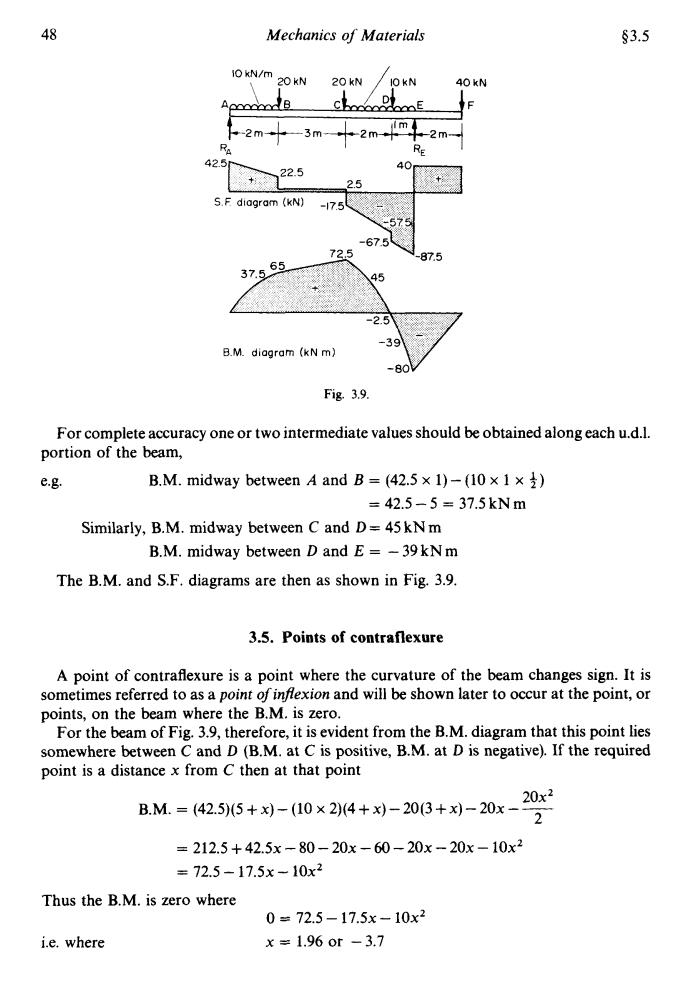
48 Mechanics of Materials §3.5 10 kN/m 20 kN 20kN O kN 40kN C 0 -2m* -3m -2m* 2m 42.5 40 22.5 2.5 S.F diagram (kN) -7.5 -67.5 72.5 87.5 37.565 45 -2.5 B.M.diagram (kN m) Fig.3.9. For complete accuracy one or two intermediate values should be obtained along each u.d.I. portion of the beam, e.g. B.M.midway between A and B=(42.5×1)-(l0×1×) =42.5-5=37.5kNm Similarly,B.M.midway between C and D=45kNm B.M.midway between D and E=-39kNm The B.M.and S.F.diagrams are then as shown in Fig.3.9. 3.5.Points of contraflexure A point of contraflexure is a point where the curvature of the beam changes sign.It is sometimes referred to as a point of infexion and will be shown later to occur at the point,or points,on the beam where the B.M.is zero. For the beam of Fig.3.9,therefore,it is evident from the B.M.diagram that this point lies somewhere between C and D(B.M.at C is positive,B.M.at D is negative).If the required point is a distance x from C then at that point B.M.=(42.55+)-(10×24+x)-203+x)-20x- 20x2 =212.5+42.5x-80-20x-60-20x-20x-10x2 =72.5-17.5x-10x2 Thus the B.M.is zero where 0=72.5-17.5x-10x2 i.e.where x=1.96or-3.7
48 Mechanics of Materials $3.5 20kN /IOkN 40 kN IO kN/m 2o kN 42 5 S F diagram (kN) .I B M diagram (kN m) Fig. 3.9. For complete accuracy one or two intermediate values should be obtained along each u.d.1. portion of the beam, e.g. B.M. midway between A and B = (42.5 x 1) - (10 x 1 x $) = 42.5 - 5 = 37.5 kNm Similarly, B.M. midway between C and D = 45 kN m B.M. midway between D and E = - 39 kN m The B.M. and S.F. diagrams are then as shown in Fig. 3.9. 3.5. Points of contraflexure A point of contraflexure is a point where the curvature of the beam changes sign. It is sometimes referred to as a point ofinflexion and will be shown later to occur at the point, or points, on the beam where the B.M. is zero. For the beam of Fig. 3.9, therefore, it is evident from the B.M. diagram that this point lies somewhere between C and D (B.M. at C is positive, B.M. at D is negative). If the required point is a distance x from C then at that point 20x2 B.M. = (42.5)(5+~)-(10 x 2)(4+~)-20(3+~)-20~-- 2 = 212.5 + 42.5~ - 80 - 20~ - 60 - 20~ - 20~ - lox2 = 72.5 - 17.5~ - lox2 Thus the B.M. is zero where i.e. where 0 = 72.5 - 17.5~ - lox2 x = 1.96 or -3.7
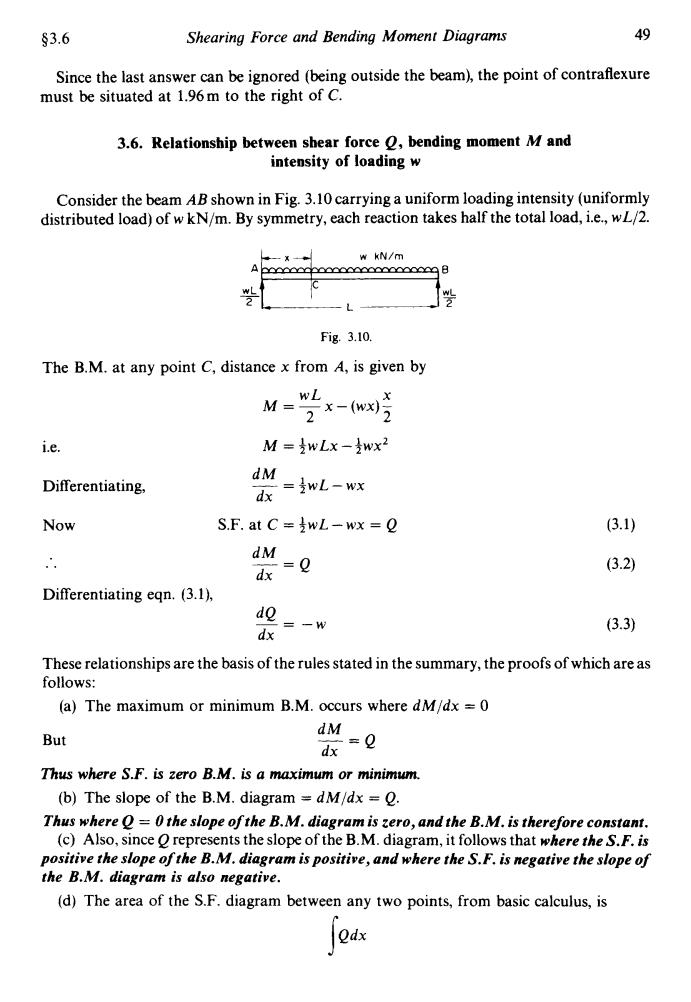
§3.6 Shearing Force and Bending Moment Diagrams 49 Since the last answer can be ignored(being outside the beam),the point of contraflexure must be situated at 1.96m to the right of C. 3.6.Relationship between shear force Q,bending moment M and intensity of loading w Consider the beam AB shown in Fig.3.10 carrying a uniform loading intensity(uniformly distributed load)of w kN/m.By symmetry,each reaction takes half the total load,i.e.,wL/2. w kN/m Fig.3.10. The B.M.at any point C,distance x from A,is given by M=x-m片 i.e. M=wLx-wx2 dM Differentiating, =wL-wx Now S.F.at C=wL-wx =Q (3.1) dM dx -0 (3.2) Differentiating eqn.(3.1), d№一w (3.3) dx These relationships are the basis of the rules stated in the summary,the proofs of which are as follows: (a)The maximum or minimum B.M.occurs where dM/dx =0 dM But 收=9 Thus where S.F.is zero B.M.is a maximum or minimum. (b)The slope of the B.M.diagram dM/dx =O. Thus where Q=0 the slope of the B.M.diagram is zero,and the B.M.is therefore constant. (c)Also,since O represents the slope of the B.M.diagram,it follows that where the S.F.is positive the slope ofthe B.M.diagram is positive,and where the S.F.is negative the slope of the B.M.diagram is also negative. (d)The area of the S.F.diagram between any two points,from basic calculus,is Qdx
$3.6 Shearing Force and Bending Moment Diagrams 49 Since the last answer can be ignored (being outside the beam), the point of contraflexure must be situated at 1.96m to the right of C. 3.6. Relationship between shear force Q, bending moment M and intensity of loading w Consider the beam AB shown in Fig. 3.10 carrying a uniform loading intensity (uniformly distributed load) of w kN/m. By symmetry, each reaction takes half the total load, i.e., wL/2. A 0 - WL EL 2 2 Fig. 3.10. The B.M. at any point C, distance x from A, is given by WL X M = - x - (wx)- 2 2 i.e. M = ~WLX -3.1.’ Differentiating, dM dx --=+wL-wx Now S.F. at C = 4wL - wx = Q (3.1) dM dx -- .. -Q Differentiating eqn. (3.1), 9- - -w dx (3.3) These relationships are the basis of the rules stated in the summary, the proofs of which are as follows: (a) The maximum or minimum B.M. occurs where dM/dx = 0 But dM dx ----=Q Thus where S.F. is zero B.M. is a maximum or minimum. (b) The slope of the B.M. diagram = dM/dx = Q. Thus where Q = 0 the slope of the B.M. diagram is zero, and the B.M. is therefore constant. (c) Also, since Q represents the slope of the B.M. diagram, it follows that where the S.F. is positive the slope of the B.M. diagram is positive, and where the S.F. is negative the slope of the B.M. diagram is also negative. (d) The area of the S.F. diagram between any two points, from basic calculus, is
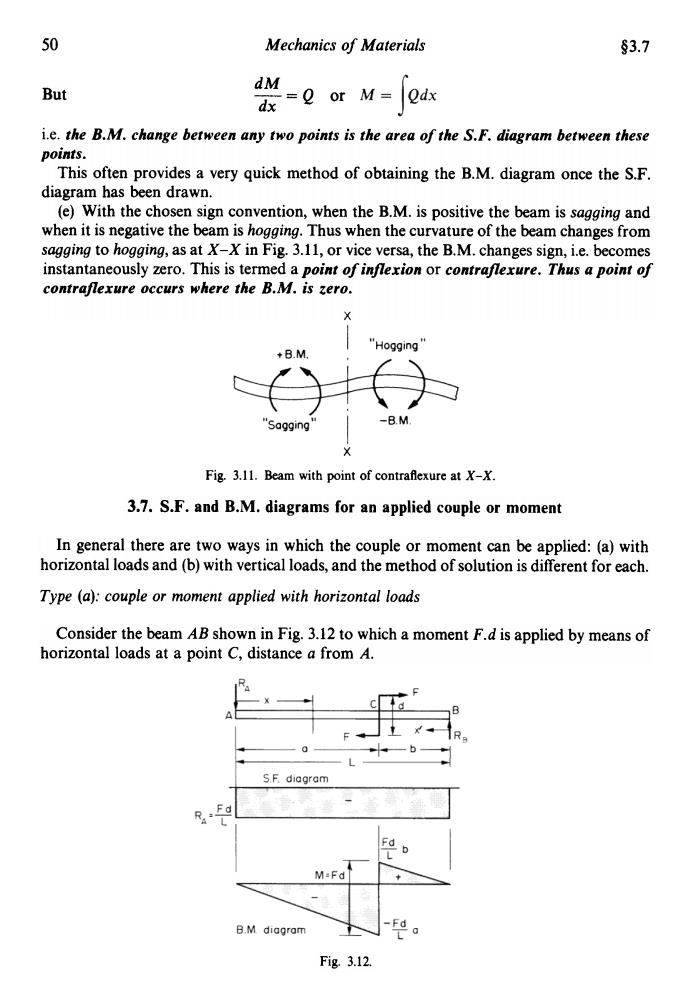
50 Mechanics of Materials §3.7 But or M-ods i.e.the B.M.change between any two points is the area of the S.F.diagram between these points. This often provides a very quick method of obtaining the B.M.diagram once the S.F. diagram has been drawn. (e)With the chosen sign convention,when the B.M.is positive the beam is sagging and when it is negative the beam is hogging.Thus when the curvature of the beam changes from sagging to hogging,as at X-X in Fig.3.11,or vice versa,the B.M.changes sign,i.e.becomes instantaneously zero.This is termed a point of inflexion or contraflexure.Thus a point of contraflexure occurs where the B.M.is zero. X +B.M. "Hogging' "Sagging -B.M Fig.3.11.Beam with point of contraflexure at X-X. 3.7.S.F.and B.M.diagrams for an applied couple or moment In general there are two ways in which the couple or moment can be applied:(a)with horizontal loads and(b)with vertical loads,and the method of solution is different for each. Type (a):couple or moment applied with horizontal loads Consider the beam AB shown in Fig.3.12 to which a moment F.d is applied by means of horizontal loads at a point C,distance a from A. S.F.diagram M-Fd B.M diagram Fd Fig3.12
50 Mechanics of Materials §3.7 dM dx But = Q or i.e. the B.M. change between any two points is the area of the S.F. diagram between these points. This often provides a very quick method of obtaining the B.M. diagram once the S.F. diagram has been drawn. (e) With the chosen sign convention, when the B.M. is positive the beam is sagging and when it is negative the beam is hogging. Thus when the curvature of the beam changes from sagging to hogging, as at x-x in Fig. 3.11, or vice versa, the B.M. changes sign, i.e. becomes instantaneously zero. This is termed a point of inflexion or contra flexure. Thus a point of contra flexure occurs where the B.M. is zero. x x Fig. 3.11. Beam with point of contraflexure at X -X . 3.7. S.F. and B.M. diagrams for an applied couple or moment In general there are two ways in which the couple or moment can be applied: (a) with horizontal loads and (b) with vertical loads, and the method of solution is different for each. Type (a): couple or moment applied with horizontal loads Consider the beam AB shown in Fig. 3.12 to which a moment F.d is applied by means of horizontal loads at a point C, distance a from A. Fig. 3.12